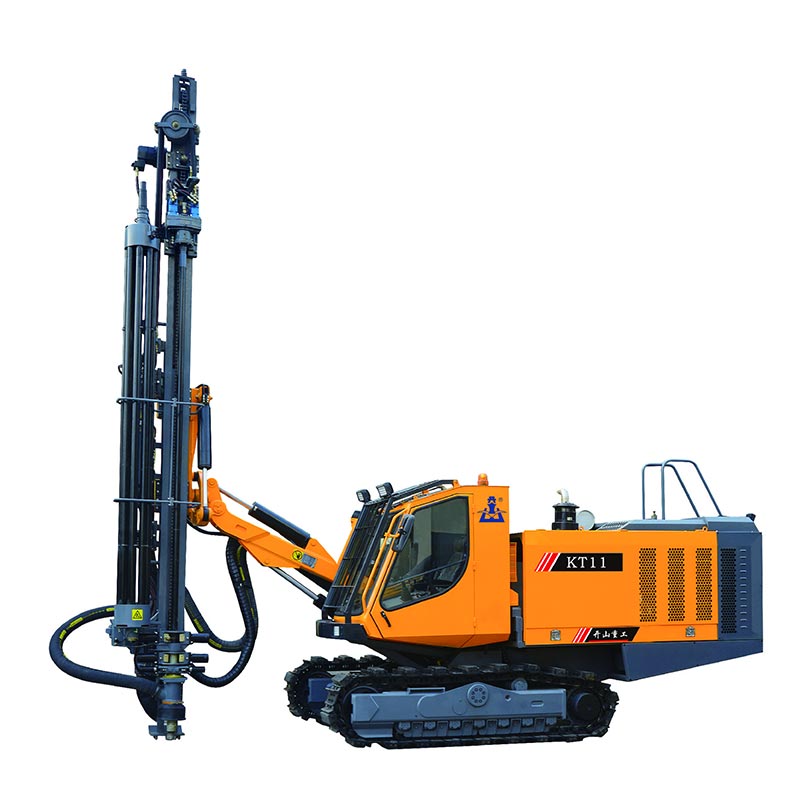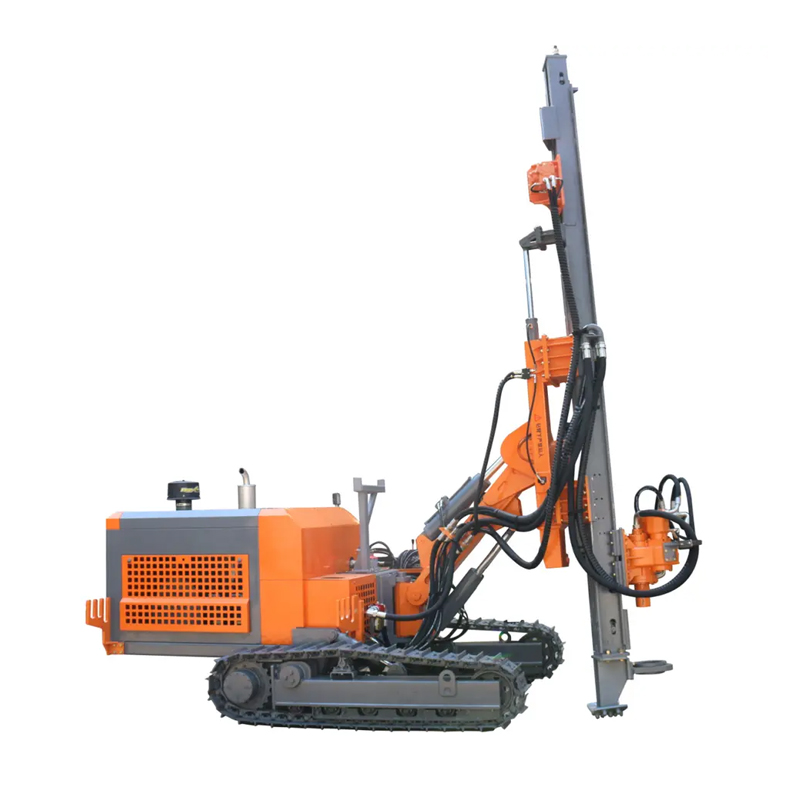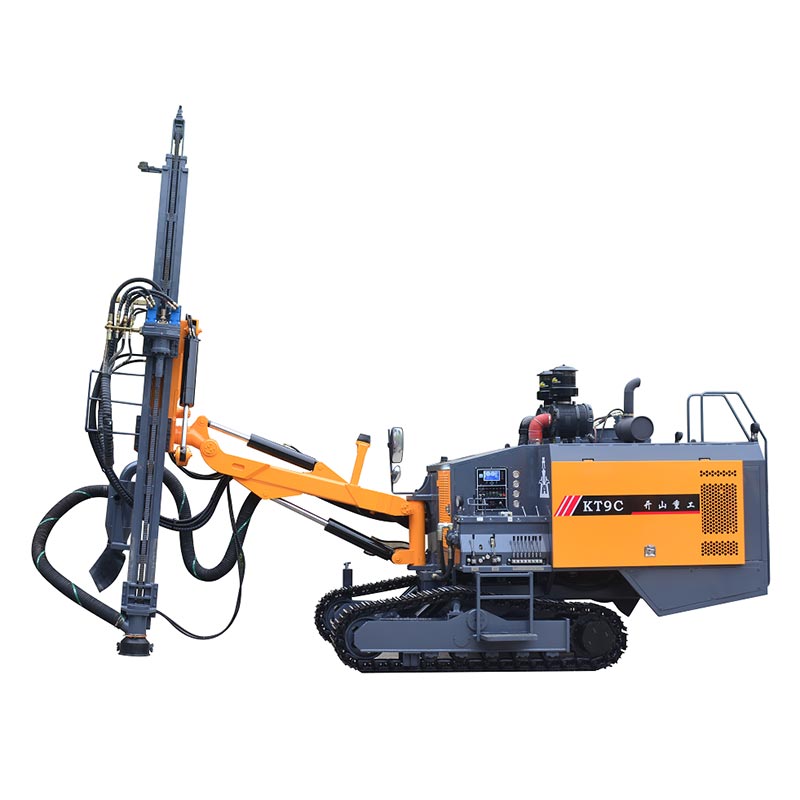1000m Depth Water Well Drilling Rig
| weight(T) | 13 | Drill pipe diameter(mm) | 102/108/114/117 |
| The hole diameter | 140-400 | Drill pipe length(m) | 1.5/2.0/3.0/6.0 |
| Drilling depth(m) | 1000 | Rig lifting force | 50 |
| One-time advance length(m) | 6.6 | Rig rise speed(m/min) | 20 |
| Walking speed(km/h) | 2.5 | Fast feeding speed(m/min) | 40 |
| Gradeability(max.) | 30 | Width of loading(m) | 2.95 |
| Equipped capacity(kw) | 194 | Hoisting force of winch(T) | 2 |
| Working air pressure(MPA) | 1.7-3.5 | Swing torque(N.m) | 9000-20000 |
| Air consumption(m³/min) | 17-42 | Dimensions(mm) | 6300*2300*2950 |
| Swing speed(rpm) | 45-140 | The penetration effciency | 15-35 |
| High leg stroke(m) | 1.7 | The engine brand | Cummins |
A 1000m depth water well drill rig is a specialized drilling machine designed to drill deep water wells, capable of reaching depths of up to 1000 meters (approximately 3280 feet). These rigs are essential for accessing groundwater in regions where surface water is unavailable or for extracting water from deep aquifers. They are commonly used in agricultural, industrial, municipal, and geotechnical applications.
Key Features and Components of a 1000m Depth Water Well Drill Rig:
1. Drilling Mechanism:
- Rotary Drilling: The rig uses a rotary drilling technique, where a rotating drill bit is powered to break through hard rock or soil. The bit is typically made of durable materials such as tungsten carbide or diamond to withstand harsh conditions.
- Percussion or DTH (Down-the-Hole) Hammer: In some cases, a percussion or DTH hammer system may be used to break through hard rock formations by delivering high-energy impacts, which helps to speed up the drilling process.
2. Drilling Mud System:
- Mud Circulation System: A pump system circulates drilling fluid (often a mixture of water, bentonite, and other additives) through the borehole. The drilling fluid serves multiple purposes: cooling and lubricating the drill bit, stabilizing the wellbore, and carrying rock cuttings to the surface.
- Mud Pit and Cleaning System: These components store, clean, and recirculate the drilling mud.
3. Power Source:
- Engine and Hydraulic Systems: The rig is typically powered by a diesel or electric engine, which drives the hydraulic pumps and the rotary system. High torque and power are essential for drilling through various types of rock and soil, especially at deeper levels.
4. Mast and Tower:
- Adjustable Mast: The mast is an adjustable tower structure that holds the drill string and allows the rig to operate vertically. It is designed to support the weight of the drill string and the equipment needed to drill at greater depths.
- Transportable: The mast can often be folded or disassembled for transportation between drill sites.
5. Drill String and Tools:
- Drill Pipes: The drill string consists of a series of connected pipes that extend into the wellbore, transmitting the rotational force from the rig to the drill bit at the bottom of the hole.
- Core Barrels: In some rigs, core barrels are used to extract core samples of the rock or soil, which can provide valuable geological information.
6. Depth Measurement and Monitoring:
- Depth Sensors: Digital or analog depth sensors are used to monitor and log the drilling progress. These sensors measure the depth of the drill bit and provide real-time feedback to the operator.
- Control System: A sophisticated control system allows the operator to monitor various parameters such as drilling speed, mud circulation, and pressure, ensuring safe and efficient drilling operations.
7. Safety Features:
- Blowout Preventer (BOP): To prevent any sudden pressure releases or blowouts, especially when drilling through pressurized formations.
- Emergency Shutdown Systems: Safety mechanisms are in place to automatically stop the drilling process in the event of an emergency.
- Rig Guards: To protect workers and equipment from falling objects and other hazards.
8. Additional Components:
- Winches and Hoists: Used for lowering and lifting the drill pipe and other heavy equipment in and out of the well.
- Mud Pumps: To circulate the drilling fluid through the system, ensuring that the drilling process remains efficient and cool.
Applications of 1000m Depth Water Well Drill Rig:
- Groundwater Exploration: To identify and tap into deep groundwater aquifers for drinking water, irrigation, or industrial use.
- Municipal Water Supply: In areas where shallow groundwater sources are insufficient, deep wells can provide a reliable source of water.
- Geotechnical and Geological Investigations: To gather subsurface data for construction projects, including infrastructure like bridges, tunnels, and buildings.
- Oil & Gas Exploration: In some cases, these rigs are also adapted for use in oil and gas exploration in addition to water well drilling.
Benefits:
- Access to Deeper Water Sources: Capable of drilling deeper than standard water well rigs, these machines can reach valuable groundwater reservoirs located far below the surface.
- Increased Efficiency: The powerful engines and robust drilling systems enable fast and efficient penetration through a variety of soil and rock types.
- Reliability and Durability: Designed for tough environments, these rigs are built to handle extreme conditions and provide long-lasting performance in remote or challenging areas.
Conclusion:
A 1000m depth water well drill rig is an essential tool for accessing deep water sources, making it vital for various industries that depend on groundwater. With advanced features like powerful rotary systems, mud circulation, and real-time monitoring, these rigs ensure that deep water wells can be drilled effectively and safely. They are invaluable in regions with deep groundwater reservoirs or when drilling for scientific, industrial, or municipal purposes.












